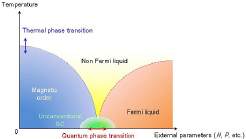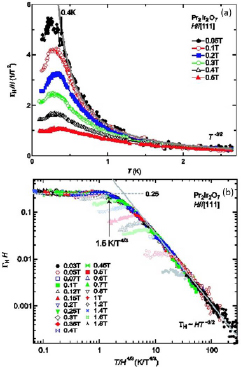Quantum Criticality in a Metallic Spin Liquid System Pr2Ir2O7
Nakatsuji Group
At finite temperatures, electronic magnetic moments in magnetic materials are thermally fluctuating and one may have magnetic phase transitions accompanied by critical thermal fluctuations. This transition temperature can be lowered by controlling external parameters like pressure and magnetic field. In temperature near absolute zero, thermal fluctuations will be reduced, allowing quantum fluctuations to take effect. When the quantum fluctuations are strong enough, one may have a phase transition at absolute zero, namely quantum phase transition. In the vicinity of the quantum phase transition point, anomalous magnetic and metallic behaviors may be observed, such as high-Tc superconductivity in the cuprates and iron pnictides, and unconventional superconductivity in the heavy fermion systems. These phenomena are stemmed from the anomalous metallic state around the quantum critical point.

Fig. 1. Schematic phase diagram of temperature (T) vs. external parameters in strongly correlated electron systems.

Fig. 2. (a) Temperature dependence of the magnetic Grüneisen ratio ΓH of Pr2Ir2O7. The divergent behavior of ΓH appears with decreasing of a magnetic field. (b) Critical scaling of the magnetic Grüneisen ratio ΓH for Pr2Ir2O7. This analysis evidences a zero-field quantum critical point in the material.
Intensive studies on quantum critical phenomena have been done on the groups of compounds so called heavy fermion systems. It is well known that the tuning of the external parameters by applying pressure or magnetic field suppresses the magnetic order down to absolute zero, leading to the emergence of quantum criticality along with the evolution of exotic phase such as anomalous superconductors. Here we have revealed the existence of quantum criticality in a metallic spin liquid system Pr2Ir2O7, which may provide a key insight on the mechanism of large spontaneous anomalous Hall effect observed in its spin liquid state [1-4]. In this material, Pr ions form the pyrochlore structure, where the vertices of the corner sharing network of tetrahedra are occupied by Pr ions' Ising type spins, and the ferromagnetic interaction between them causes geometrically frustrated spin ice state. As a result, the ground state is considered to be spin liquid, having no dipolar magnetic order. In addition, the spontaneous Hall effect appears in this spin liquid phase, suggesting the emergence of a chiral spin liquid state which has finite spin chirality.
In this study, we performed the precise magnetocaloric effect measurements on Pr2Ir2O7 [1]. The magnetic Grüneisen ratio, which measures the change of temperature with magnetic field under adiabatic conditions, generally is known to diverge at the quantum critical point, and thus this physical quantity is very sensitive to the existence of quantum criticality.
The results show the divergence of magnetic Grüneisen ratio, indicating the existence of quantum criticality. In addition, the critical scaling which examines the position of a quantum critical point, suggests that Pr2Ir2O7 has a quantum critical point at zero magnetic field. Therefore, this system is located at a zero-field quantum critical point without tuning of any external parameter.
In summary, we have found the zero-field quantum criticality in Pr2Ir2O7 as indicated by the divergent Grüneisen ratio and zero-field quantum critical point. All these results suggest that the chiral spin liquid phase accompanied with the spontaneous Hall effect emerges under the influence of the quantum criticality led by geometrical frustration. This supports the manifestation of novel type of "quantum critical spin liquid" states. Our study highlights the spin ice as the parent state of the chiral spin liquid state, inducing the spontaneous Hall effects and many other intriguing quantum magnetic phenomena as represented by coherent propagation of monopoles. Our findings of quantum criticality which emerges in a spin liquid state of a highly frustrated metal require further studies, both experimental and theoretical, on the group of frustrated metals.
References
- [1] S. Nakatsuji et al., Phys. Rev. Lett. 96, 087204 (2006).
- [2] Y. Machida, S. Nakatsuji, Y. Maeno, T. Tayama, T. Sakakibara, and S. Onoda, Phys. Rev. Lett. 98, 057203 (2007).
- [3] L. Balicas, S. Nakatsuji, Y. Machida, and S. Onoda, Phys. Rev. Lett. 106, 217204 (2011).
- [4] Y. Machida, S. Nakatsuji, S. Onoda, T. Tayama and T. Sakakibara, Nature 463, 210 (2010).
- [5] Y. Tokiwa, J. J. Ishikawa, S. Nakatsuji, and P. Gegenwart, Nat. Mater. 13, 356 (2014).
